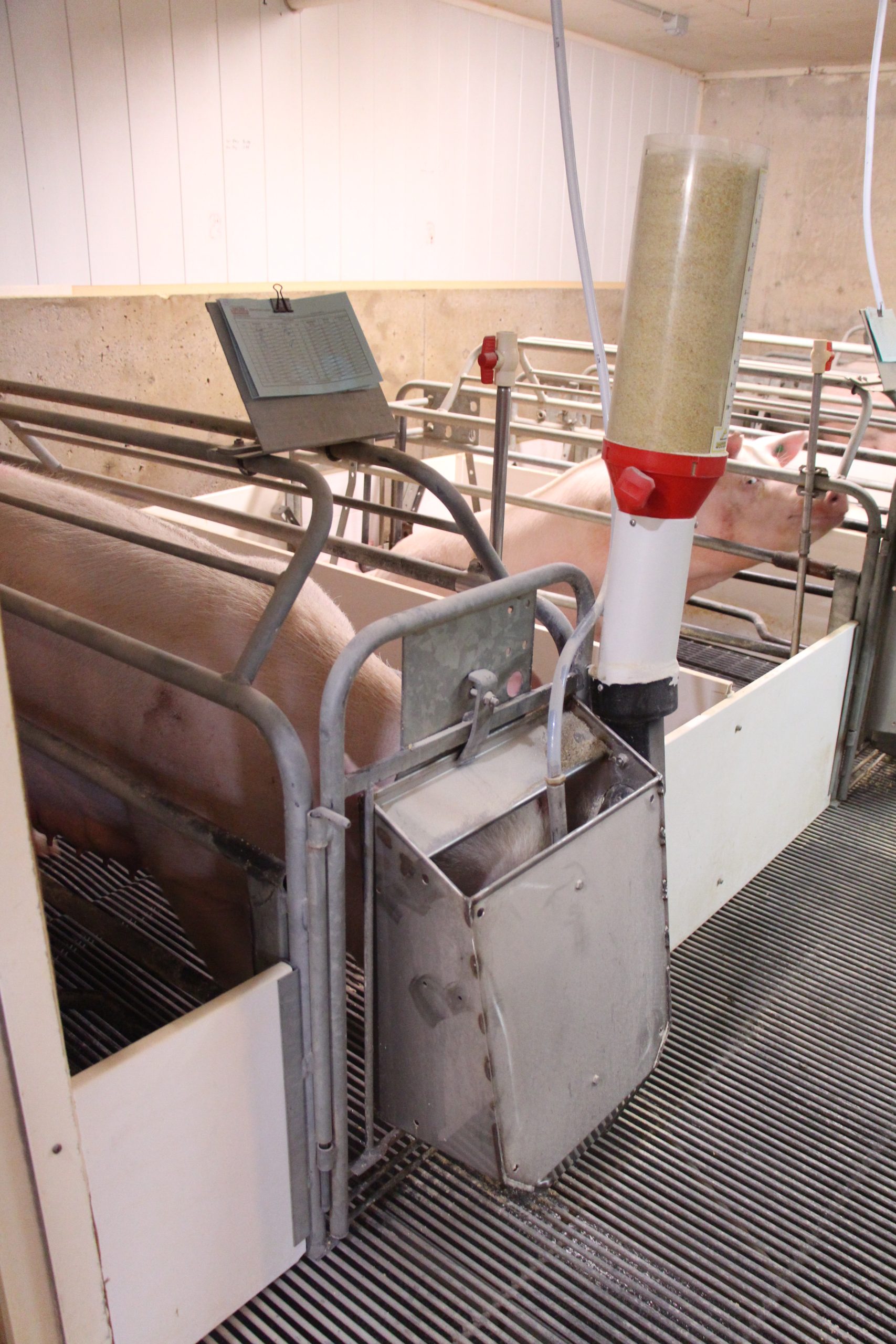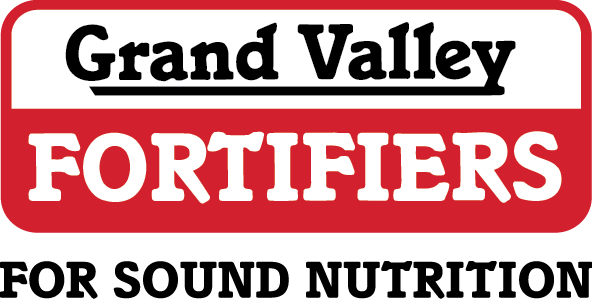Agriculture and Agri-Food Canada,
Sherbrooke Research and Development Centre, QC, Canada
Swine producers are currently using sow genetic lines with very high litter sizes and, even though beneficial, this creates new dilemmas in the farrowing house. The problems of longer farrowings, greater stillbirth rate, and inadequate colostrum and milk intakes by individual piglets are often encountered. More attention needs to be given to the crucial period of transition between late gestation and early lactation to develop the best feeding and management strategies to assist sows and their progeny.
Feed Intake
The transition period covers approximately the last week of gestation until a few days after farrowing. This is a crucial period when sows undergo major metabolic changes and must use their body reserves because of an imbalance between intake and use of nutrients. The energy status of sows is important for successful farrowings, with both inadequate and excess energy intakes having negative effects. Farrowing duration was shorter with minimal required assistance and lower stillbirth rate when sows were fed 3.7 to 4.1 kg/day of a lactation diet during the last week of gestation (Feyera et al., 2021). Time of farrowing relative to the last meal is important as farrowing duration was constant and shorter (3.8 ± 1.5 hours) when farrowings started within 3.1 ± 0.3 hours of the last meal, but farrowing duration increased to 9.3 hours with more stillbirths when farrowings started 8 hours after the last meal (Feyera et al., 2018). On the other hand, providing ad libitum feeding or four daily meals of a lactation diet from day 113 of gestation until farrowing did not alter farrowing duration or incidence of stillbirths when farrowing duration in the herd averaged 3.5 hours (Gourley et al., 2020). It is apparent that beneficial effects of energy status at farrowing may depend on the duration of farrowing and litter size normally seen in the herd. An adequate supply of nutrients during transition is also important to sustain the highly accelerated mammary development and the synthesis of colostrum. Decaluwé et al. (2014) reported that a very low feed supply (1.5 vs. 4.5 kg/day) from day 108 of gestation until farrowing tended to decrease colostrum yield and caused excessive mobilization of body reserves. Garrison et al. (2017) fed sows 1.5, 3.0 or 4.5 kg/day from day 104 of gestation until farrowing and reported a 9 g increase in colostrum yield with each 1 kg increase in daily feed intake. According to Feyera et al. (2021), who fed first- and second-parity sows 1.8 to 5.0 kg/day from day 108 of gestation until farrowing, colostrum yield was maximal at 3.0 kg/day. Interestingly, recent findings showed that feed intake during the last week of gestation could impact subsequent sow milk yield. Bruun et al. (2023) compared feed intakes ranging from 1.8 to 5.0 kg/day from day 108 of gestation until farrowing in first- and second-parity sows, and a feed supply of 4.0 to 4.1 kg/day maximized average milk yield in the subsequent lactation.

Protein Intake
Taking into account the increased nutrient requirements of sows during late gestation, the gestation diet may not meet these needs. Lactation diets contain more protein than gestation diets and feeding a lactation diet instead of a gestation diet from day 107 of gestation until farrowing increased colostrum intake by piglets (127 versus 96 g) as well as piglet weaning weights (Garrison et al., 2017). Recent results indicate that dietary protein in the last week of gestation can also have a carry-over effects on subsequent milk production. Multiparous sows fed increasing levels of lysine (15.2 to 32.6 g/day of SID lysine) with a feed allowance of 3.8 kg/day from day 108 of gestation until 24 hours after the onset of farrowing, had optimal milk yield with a daily lysine intake of 22.0 g (Johannsen et al., 2024). On the other hand, Pedersen et al. (2020) found no carry-over effect of dietary protein supply (19.2 to 28.8 g SID lysine/day) during transition on milk yield, which may have been due to a below optimal feed intake.
Taking into account the increased cost of feeding a lactation diet in transition, the option of providing a daily blend of gestation and lactation diets that is adapted to meet the sow requirements could be an option. When sows were fed 2 kg of either a lactation diet or a daily blend of gestation and lactation diets (to best meet lysine and energy requirements) as of day 104 of gestation, the blend of diets increased body weight and backfat thickness of sows after farrowing, while piglet weaning weight was unaltered (Gregory and Huber, 2024). Transition feeding programs using such a blend therefore reduces energy mobilization by the sow during late gestation and has no detrimental effect on subsequent lactation performance. The major drawback, however, is the cost of the feeding system needed to make such a blend.
Fibre Intake
Constipation is commonly seen in late-pregnant sows and it can lead to prolonged farrowings. Dietary fibres have been used to reduce the incidence of constipation. Supplementing the diet of sows in the transition period (7 days before to 3 days after farrowing) with 75 g per day of lignocellulose decreased the rate of constipation from 46.3% to 17.6% without altering farrowing duration (Dumniem et al., 2024). When treated sows had 16 or more piglets, the increased fibre intake also tended to reduce farrowing duration (202.0 versus 287.5 minutes). Dietary fibre supplementation during the transition period may therefore be beneficial, mostly in sows with large litters.
Take home messages:
01. Special care must be provided when feeding sows during the transition period between gestation and lactation because they may be lacking energy and protein at this critical time.
02. A feed intake between 3.7 and 4.1 kg/day during the last week of gestation can decrease farrowing duration and stillbirth rate.
03. Farrowing duration was shorter and stillbirth rate lower when sows were provided feed in the 3.1 h preceding the onset of farrowing.
04. Colostrum yield was maximal with a daily feed intake of 3.0 kg from day 108 of gestation until farrowing.
05. Feeding a lactation diet from day 107 of gestation until farrowing increased colostrum intake and piglet weaning weights.
06. Dietary supplementation with fibre can decrease constipation and farrowing length, and this mainly in litters of 16 or more piglets.
References:
• Bruun, T.S., M. Eskildsen, C.K. Hojgaard, N.P. Nørskov, K.E.B. Knudsen, P.K. Theil and T. Feyera, T. 2023. Feeding level during the last week of gestation can influence performance of sows and their litters in the subsequent lactation. J. Anim. Sci. 101:1-11. doi:10.1093/jas/skad349.
• Decaluwé, R., D. Maes, A. Cools, B. Wuyts, S. De Smet, B. Marescau, D. Paul and G. Janssens. 2014. Effect of peripartal feeding strategy on colostrum yield and composition in sows. J. Anim. Sci. 92:3557-3567. doi: 10.2527/jas.2014-7612
• Dumniem, N., R. Boonprakob, C. Panvichitra, S. Thongmark, N. Laohanarathip, T. Parnitvoraphoom, S. Changduangjit, T. Boonmakaew, N. Teshanukroh and P. Tummaruk. 2024. Impacts of fibre supplementation in sows during the transition period on constipation, farrowing duration, colostrum production, and pre-weaning piglet mortality in the free-farrowing system. Animals 14 doi: 10.3390/ani14060854.
• Feyera, T., T.F. Pedersen, U. Krogh, L. Foldager and P.K. Theil. 2018. Impact of sow energy status during farrowing on farrowing kinetics, frequency of stillborn piglets, and farrowing assistance. J. Anim. Sci. 96 2320-2331.
• Feyera, T., S.J.W. Skovmose, S.E. Nielsen, D. Vodolazska, T.S. Bruun and P.K. Theil. 2021. Optimal feed level during the transition period to achieve faster farrowing and high colostrum yield in sows. J. Anim. Sci. 99:1-11. doi: 10.1093/jas/skab040
• Garrison, C., E. Van Heugten, J. Wiegert and M. Knauer. 2017. Got colostrum? Effect of diet and feeding level on piglet colostrum intake and piglet quality. J. Anim. Sci. 95:113-113. doi: dx.doi. org/10.2527/asasmw.2017.12.236
• Gourley, K.M., A.J. Swanson, R.Q. Royall, J.M. DeRouchey, M.D. Tokach, S.S. Dritz, R.D. Goodband, C.W. Hastad and J.C. Woodworth. 2020. Effects of timing and size of meals prior to farrowing on sow and litter performance. Transl. Anim. Sci. 4 724-736.
• Gregory, N. and L. Huber. 2024. Blending gestation and lactation diets during the transition period reduces energy mobilization by sows in late gestation, with no impact on subsequent lactation performance. Transl. Anim. Sci. 8 doi: 10.1093/tas/txae096.
• Johannsen, J.C., M.T. Sørensen, P.K. Theil, T.S. Bruun, C. Farmer and T. Feyera. 2024. Optimal protein concentration in diets for sows during the transition period. J. Anim. Sci. 102: 1-6. doi.org/10.1093/ jas/skae082.
• Pedersen, T.F., S. van Vliet, T.S. Bruun and P.K. Theil. 2020. Feeding sows during the transition periodisa gestation diet, a simple transition diet, or a lactation diet the best choice? Transl. Anim. Sci. 4:34- 48. doi: 10.1093/tas/txz155.
This article was written for the Summer 2025 Swine Grist. To read the whole Swine Grist, click the button below.
This article was also written for the Summer 2025 Western & Prairie Swine Grist. To read the whole Western Swine Grist, click the button below.

